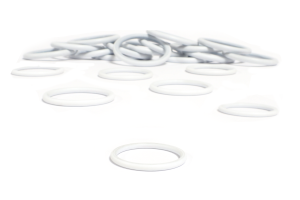PTFE O-RINGS | MATERIALS SIMPLY EXPLAINED
What are PTFE O-rings?
PTFE O-rings are real all-rounders.
This becomes clear when you add that the material has also borne the manufacturer’s name Teflon™ since its market launch.
Its almost universal media resistance and extremely wide temperature range make the material a valuable resource for many applications.
In the field of O-rings, however, PTFE is an exotic material: because it lacks the elastic properties of elastomers, there are some decisive differences in its manufacture and use.

Feature | Value |
|---|---|
ISO designation | PTFE |
Trade names | Teflon |
Chemical name | Polyetrafluoroethylene |
Media resistance | Almost universal media resistance |
Temperature resistance | -260°C to +200°C |
Standard color | White |
Standard hardness | 60 Shore D |
Industries | Food and pharmaceuticals, chemicals, pipelines |
Production | Plastic turning |
Tolerances | DIN ISO 3601 |
Durability | 20 years |
REQUEST PTFE O-RINGS QUICKLY AND EASILY?
Almost any dimension available
Over 10,000 FKM dimensions available from stock
Offer received in record time
No minimum order values or minimum quantities
#1 The 5 most important advantages of PTFE O-rings
1. Extreme frost resistance
2. Excellent sliding and static friction
3. Universal media resistance
4. Suitable for the food and pharmaceutical industries
5. Low thermal conductivity
PTFE O-rings can cover an extremely wide temperature range. Under the right circumstances, however, continuous temperatures of -200 to 260 degrees can be reached.
In the high-temperature range, only O-rings made of FKM and FFKM of similar heat resistance can be used.
withstand.
Due to the very low friction values PTFE O-rings are extremely wear-resistant. During movement, they slide over the components to be sealed, which protects the O-ring from mechanical damage.
A weakening of the sealing effect due to the loss of material from the O-ring therefore hardly ever occurs.
PTFE O-rings are also stable in contact with almost all media. Even aggressive acids can hardly weaken the sealing properties. Only liquid alkali metals and fluorine gas under pressure represent gaps in the resistance profile.
The fact that PTFE O-rings hardly react with the surrounding media also ensures that they are physiologically harmless. The O-rings are therefore available in many FDA-compliant grades for use in the food and pharmaceutical sectors.
A comparison of the most important O-ring materials
Material | Temperature resistance | Chemical resistance | Elasticity |
|---|---|---|---|
NBR | -30°C to +120°C | Low | High |
HNBR | -30°C to +150°C | Medium | High |
EPDM | -45°C to +150°C | Medium | High |
SILICONE | -60°C to +200°C | Low | High |
FKM (VITON) | -25°C to +200°C | Medium | High |
FEP coated | -60°C to +200°C | High | Medium |
PTFE | -250°C to +250°C | High | Low |
FFKM | -40°C to +340°C | High | High |
#2 The 3 most common areas of application for PTFE O-rings
Food and pharmaceutical industry
PTFE O-rings in solid design are always FDA-compliant. They are therefore used in the food and pharmaceutical industries.
They not only benefit from their inert properties. They ensure that there is no undesirable influence on the products during production.
In addition, PTFE’s high upper temperature limit and media resistance ensure that the O-rings can withstand the aggressive cleaning procedures used in production facilities.
CIP (Cleaning in Place) and SIP (Sterilization in Place) expose the seals to high temperatures and acids. For FDA-compliant use, PTFE compounds with a hardness of 57 Shore D are used.
Chemical industry
In chemical industry plants, the focus is also on the safety of production processes.
However, economic efficiency is even more important here. This results in the corresponding requirements for sealing elements. They have to withstand high pressures, aggressive media and changing temperature conditions over the long term.
PTFE O-rings are therefore widely used in the chemical and petrochemical industries.
Pipeline construction
Fittings are used in pipeline construction for the quick and detachable connection of different components.
PTFE O-rings are ideal for use in flange and cover gaskets. These are static seals for connecting media-carrying components or for inspection openings, for example.
Due to the good accessibility of the installation grooves, the low elasticity of the material hardly plays a role. In contrast, the very good media resistance of PTDE comes into its own in pipeline construction.
#3 What is the media resistance of PTFE O-rings?
Sealing elements made of PTFE can be used almost universally with all media.
PTFE O-rings are preferably used where the chemical resistance of sealing elements made of conventional elastomer materials is not sufficient.
The material properties also remain permanently stable in ambient air. This is a significant advantage over NBR O-rings, for example, which can develop deep cracks when exposed to ozone when installed.
There are only a few exceptions to the media resistance of PTFE O-rings. The use of PTFE should be avoided , especially in combination with alkali metals and elemental hot fluorine.
Halogen-containing compounds can migrate through PTFE. However, they do not cause permanent swelling because the temporary increase in volume disappears again without leaving any residue.
On the one hand, the substances do not lead to unwanted changes in the material properties of PTFE. At the same time, the media cannot release any components from the material that could contaminate medical products during the production process, for example.
#4 What is the temperature resistance of PTFE O-rings?
PTFE O-rings have a temperature resistance of -260°C to +200°C.
PTFE O-rings cover a very wide temperature range. In terms of temperature resistance, there are only a few O-ring materials that can cover a similar range of operating temperatures.
Silicone catheters (VMQ) also reach continuous temperatures of over 200 degrees, but unlike PTFE they are not resistant to acids and alkalis, water vapor or fuels.
However, particularly critical applications that combine high demands on temperature and media resistance with elastic properties require O-ring materials other than PTFE.
Here the perfluoro rubber FFKM is the most efficient alternative to PTFE. Although the low temperature for FFKM is higher, FFKM is a particularly high-performance material.
The costs for FFKM O-rings are at a comparatively high level.
#5 What are the mechanical properties of PTFE O-rings?
1. Excellent abrasion behavior
2. Hardly any elastic recovery
3. High hardness
The lack of elastic recovery largely rules out the use of PTFE O-rings for dynamic seals.
Both in the design of the sealing system and in the installation these properties should be given special consideration. Excessive stretching during installation must be avoided at all costs so that the O-ring can return to its original shape.
The grooves should be designed accordingly. However, the lack of elasticity is accompanied by a high degree of hardness. Thanks to this property, PTFE O-rings can also withstand high pressure.
For this reason, the material is also the standard material for support rings, which act as additional components to protect elastomer O-rings against pressure-related gap extrusion.
The mechanical wear of O-rings is not only important for dynamic seals relevant. The O-ring can also be in motion in static seals.
For example, external influences can change the positioning of the components to be sealed in relation to each other.
In addition, changing pressure conditions in the sealing system cause the O-ring to move. Due to the low static and sliding friction of PTFE O-rings, they are hardly damaged.
#6 What do I have to consider when designing the groove of a PTFE O-ring?
1. Preferred use in flange connections or cover gaskets
2. Installation in closed groove of a piston seal only possible to a limited extent
3. Select O-ring dimensions identical to the nominal dimension of the seal
4. Compression of the cord cross-section between 10 and 15 percent
5. Crimping should be carried out half on each side of the cord cross-section
6. O-rings in all dimensions can be manufactured flexibly by machining
PTFE O-rings do not have the elastic properties of elastomers. Your resilience is therefore severely limited. The seals must therefore be designed accordingly.
For high durability, the installation grooves should be easily accessible. In contrast, there is greater flexibility in the dimensioning of the O-rings. PTFE O-rings are manufactured by machining and not by the use of forming tools, which means that special dimensions are available at very short notice.
If the outer diameter exceeds the maximum dimension of standard semi-finished products, the segments are welded together.
What should I bear in mind when fitting PTFE O-rings?
1. no greasing necessary during assembly
2. grouting only possible once due to permanent deformation
3. with slotted O-rings, pay attention to the orientation of the slot
4. avoid expansion of the O-ring
5. use mounting aid for installation in closed groove
Due to the low friction of the PTFE surface, the O-rings slide smoothly without assembly grease into position without assembly grease.
Special care is required when fitting slotted PTFE O-rings: the spring effect of the slot partially compensates for the lack of elasticity of the material. In order for the effect to unfold, the ring must be installed in such a way that it is spread open by the pressure.
PTFE O-rings are only suitable for one-off installation. Due to the tendency to cold flow, permanent deformation already occurs with the first compressive load.
Important: Always mount the expansion slot of slotted PTFE O-rings against the pressure application
#7 Further important information on PTFE O-rings
Finally, we would like to answer a few questions that we are frequently asked in everyday life.
#7. 1 Are PTFE and Teflon O-rings the same?
Yes, PTFE and Teflon O-rings are the same thing.
“Teflon” is a common trade name for PTFE worldwide.
#7.2 Where can I find the PTFE data sheet?
You can easily view the data sheet for our PTFE O-rings directly on our website and download it if you wish.
#7.3 What is the PTFE O-ring temperature range?
Standard PTFE has a high temperature resistance from -260°C to +200°C. There are also other PTFE variants that can withstand higher or lower temperatures.
In these cases, other materials are added to the PTFE plastic. For example, PTFE is often filled with glass or carbon fibers to compensate for known weak points of PTFE.
“I am convinced that we should share our knowledge with the world. I hope I have been able to answer all your questions. If you have any further questions, please feel free to contact us at any time. We will be happy to help you.”

Lord of the O-rings
Author of the sealing academy
